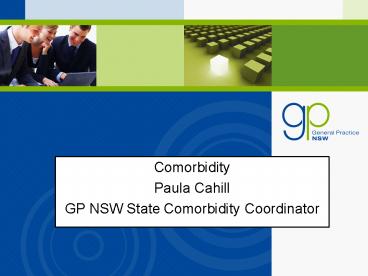Comorbidity - PowerPoint PPT Presentation
1 / 19
Title:
Comorbidity
Description:
Comorbidity. Paula Cahill. GP NSW State Comorbidity Coordinator. Let's do the time warp again! ... Comoridity is defined as to co-existence of mental health and ... – PowerPoint PPT presentation
Number of Views:872
Avg rating:3.0/5.0
Title: Comorbidity
1
- Comorbidity
- Paula Cahill
- GP NSW State Comorbidity Coordinator
2
Lets do the time warp again!
3
Comorbidity
- Comoridity is defined as to co-existence of
mental health and drug and alcohol disorders - Not just chronic and severe disorders
- Not just an issue for mental health, but also
chronic physical health problems
4
Comorbidity
- Most prevalent problem drugs
- Tobacco
- Alcohol
- Cannabis
- prescription drugs
- Most common mental health comorbidities
- Mood disorders (depression, anxiety)
- personality disorders,
5
Drug related Deaths
- 80 due to tobacco use (16.6 population daily
smokers) - 16 caused by excessive use of alcohol
- 4 caused by other drugs
- The following drugs accounted for largest numbers
of deaths in the 14-29 year old age group - Tobacco - 5
- Alcohol - 53
- Other drugs - 42
6
Comorbidity
- Complex, range of disorders, severity fluctuates
- Disorders may be primary, secondary or
independent of each other - Prevalence rates have been estimated in clinical
populations from between 20 and 75 depending on
diagnosis
7
For the person / family
- Poorer treatment outcomes
- Difficulty accessing treatment
- Increased frequency of relapse, hospitalisation,
suicide attempts and violence - Poorer social outcomes legal probs, family and
financial problems, increased rates of
incarceration, homelessness and housing
instability
8
For services
- Separate cultures and philosophies of service
provision - Separate funding, administration, training, aims,
locations - Strict entry criteria that exclude people with
one or more disorder - Symptoms of substance use disorder can interfere
in psychiatric rehab program and visa versa - Lack of cross sector training and support between
services - Difficulties in clinical assessments and
identifying best practice approaches
9
What does this mean for General Practice?
- 85 population will see GP at least once in any
year - GPs have greatest opportunity to identify early
and provide brief interventions, treatment - youth populations comorbidity most prevalent in
this group, most likely to see GP - More people in General practice with comorbid
mhda problems
10
What are the barriers
- Time constraints
- Complexity of presentations
- Skills and confidence
- Difficulty recognizing problems early
- Lack of support service / appropriate
interventions - System problems care pathways, ping pong
treatment - Interest / attitude
11
(No Transcript)
12
Where do GPs / Div work?
- All and in linking GPs to other systems
- Universal screening programs, education
programs - Selective population based programs
- Indicated early intervention
- Treatment evidence based, referral to
specialist services - Maintenance monitoring, relapse risk
13
Stages of Change
- Developed by Prochaska Diclemente to explain
tobacco use - Just as relevant when developing change programs
for organisations
14
(No Transcript)
15
At a Divisional level
- Pre-contemplative practices
- Information strategies
- Contemplative
- Motivational, more active follow-up
- Action
- Strategy mentoring, screening tools, training,
involve in advocacy - Maintenance
- Critical feedback, ongoing support, problem
solving, mentoring
16
Opportunities for Divisions
- Comorbidity projects funded
- Education programs General Practitioners
- Practice nurse support
- ATAPS
- Integration
- Mapping services and directories for General
Practices - Identifying referral pathways, but making them
work - Co-joint education and training opportunities
- Engagement of services and advocacy for General
Practice lack of support
17
Opportunities for Divisions
- Consumer / Carer
- Linking the consumer / carer perspective into
planning and education - Providing practices with information for
consumers / carers eg directories - Aboriginal health
- Linking aboriginal health workers in with
training opportunities - Links between Aboriginal health organisations and
Divisions General Practices
18
Opportunities for Divisions
- Physical health / chronic care
- Brief alcohol intervention and mental health
screen in diabetes care plans - Perinatal care alcohol / tobacco / cannabis
brief interventions as well as mental health
screen - Cardiac programs inclusion of mhda info,
screening and brief interventions - Non-judgemental approach
19
Resources that are available
- Can Do
- Teams of Two case studies
- Managing the Mix resource kit
- Dept Veterans Affairs alcohol brief
interventions guide / training program - NSW Health Comorbidity Guidelines
- Specialist Advisory Services
- Your friendly State team Meg, Paula and Ciara































